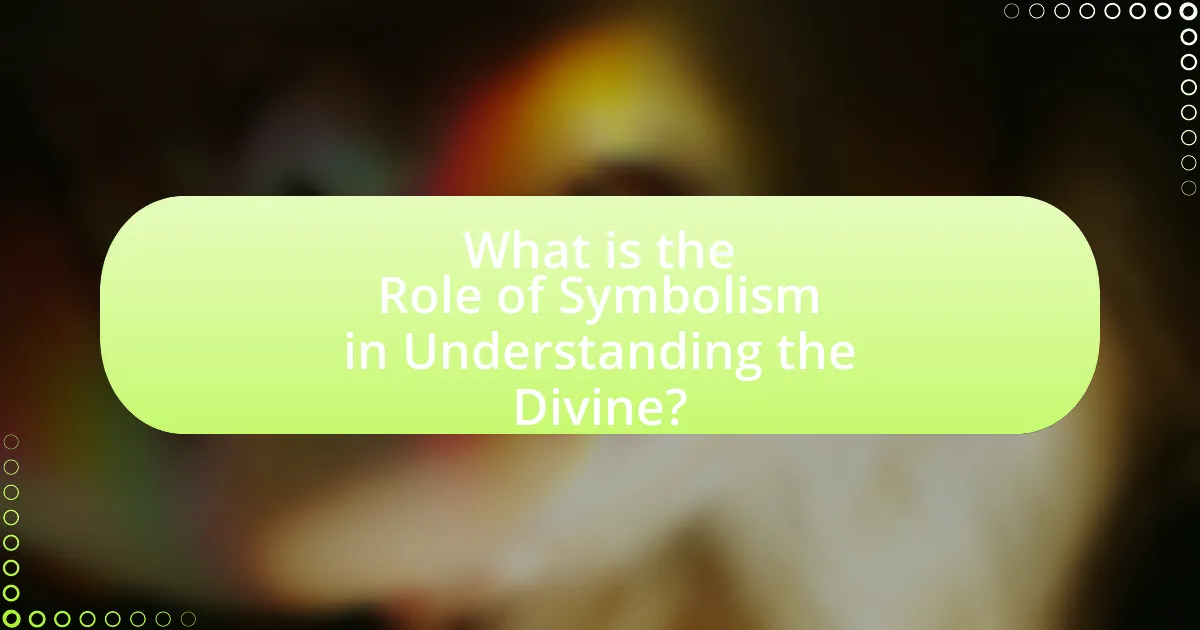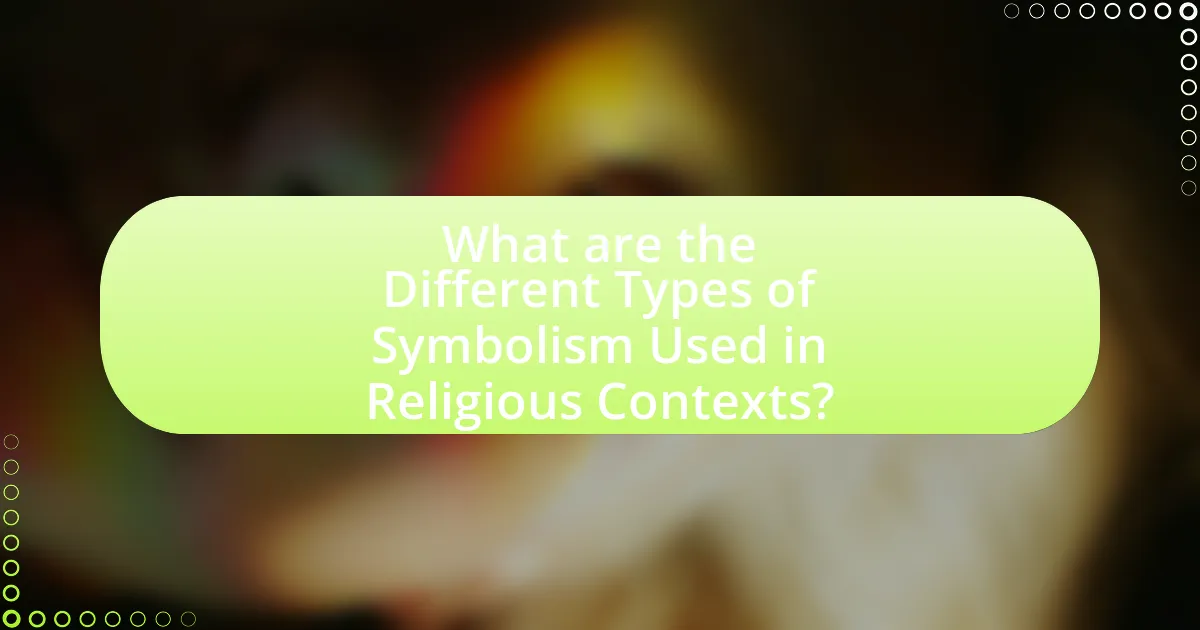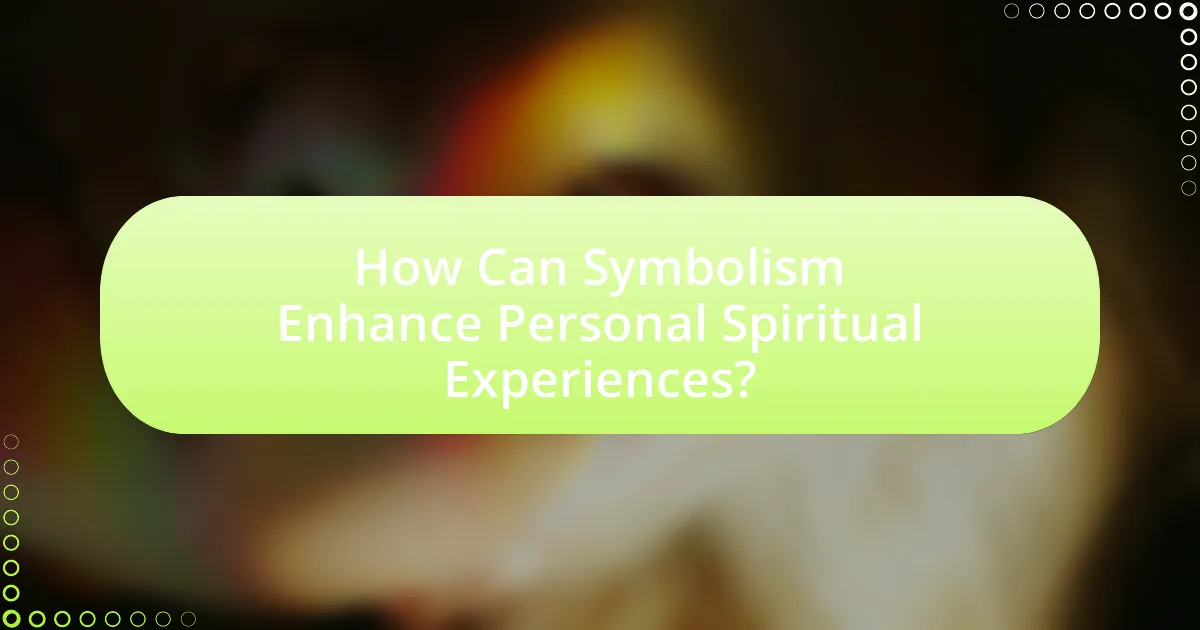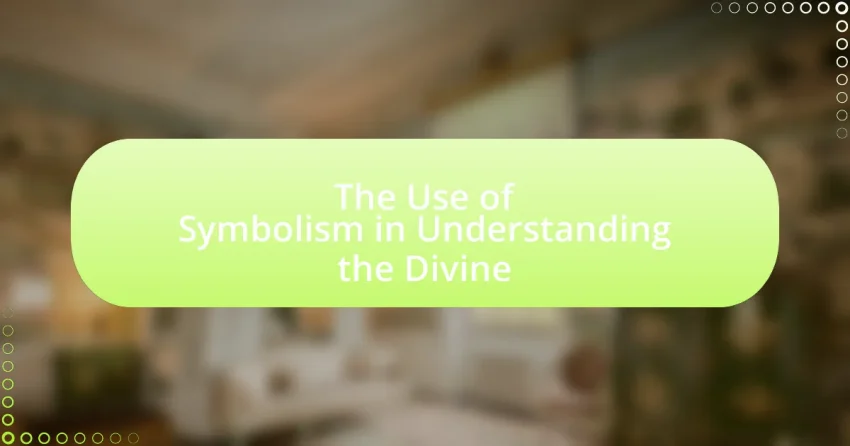The article examines the role of symbolism in understanding the divine, highlighting how symbols serve as tangible representations of complex spiritual concepts across various religious traditions. It discusses key symbols such as the cross, lotus flower, ankh, and halo, and their varying interpretations across cultures. The significance of symbolism in religious texts, rituals, and personal spiritual experiences is explored, along with the challenges of interpreting these symbols due to cultural differences and historical contexts. Additionally, practical strategies for incorporating symbolism into daily spiritual practices are provided, emphasizing its importance in enhancing personal growth and understanding of the divine.

What is the Role of Symbolism in Understanding the Divine?
Symbolism plays a crucial role in understanding the divine by providing a means to express complex spiritual concepts and experiences that are often beyond human comprehension. Symbols serve as tangible representations of abstract ideas, allowing individuals to connect with the divine on a deeper emotional and intellectual level. For instance, in various religious traditions, symbols such as the cross in Christianity or the lotus flower in Buddhism encapsulate profound theological meanings and spiritual truths, facilitating a shared understanding among followers. This use of symbolism is supported by studies in religious psychology, which indicate that symbols can evoke feelings of reverence and connection, enhancing the overall spiritual experience.
How does symbolism help convey complex divine concepts?
Symbolism effectively conveys complex divine concepts by providing tangible representations of abstract ideas. For instance, in various religious traditions, symbols like the cross in Christianity or the lotus flower in Buddhism encapsulate profound spiritual truths, making them accessible to followers. These symbols serve as visual metaphors that encapsulate intricate beliefs, allowing individuals to grasp and reflect on divine principles without needing extensive theological knowledge. The use of symbolism simplifies the communication of complex ideas, facilitating deeper understanding and personal connection to the divine.
What are the key symbols commonly associated with the divine?
Key symbols commonly associated with the divine include the cross, the lotus flower, the ankh, and the halo. The cross represents the crucifixion of Jesus Christ in Christianity, symbolizing sacrifice and redemption. The lotus flower signifies purity and spiritual awakening in Hinduism and Buddhism, emerging beautifully from muddy waters. The ankh, an ancient Egyptian symbol, represents eternal life and the union of opposites. The halo, often depicted around the heads of saints and divine figures, signifies holiness and divine light. These symbols are widely recognized across various cultures and religions, reinforcing their significance in understanding the divine.
How do these symbols vary across different cultures?
Symbols vary significantly across different cultures, reflecting unique beliefs, values, and historical contexts. For instance, the cross symbolizes Christianity in Western cultures, representing sacrifice and salvation, while in some Eastern cultures, the lotus flower signifies purity and spiritual awakening. Additionally, the color red holds different meanings; it represents luck and prosperity in Chinese culture, whereas in some Western contexts, it can symbolize danger or love. These variations illustrate how cultural backgrounds shape the interpretation and significance of symbols, influencing religious practices and societal norms.
Why is symbolism important in religious texts?
Symbolism is important in religious texts because it conveys complex spiritual truths and concepts in a way that is accessible and relatable to believers. Religious symbols, such as the cross in Christianity or the lotus flower in Buddhism, encapsulate profound meanings that resonate with followers, facilitating deeper understanding and connection to the divine. For instance, the cross represents sacrifice and redemption, central themes in Christian theology, allowing adherents to grasp the significance of Jesus’ crucifixion and resurrection. This use of symbolism not only enriches the narrative but also serves as a tool for teaching moral lessons and guiding spiritual practices, making abstract ideas tangible and fostering a sense of community among practitioners.
What are examples of symbolic language in sacred scriptures?
Examples of symbolic language in sacred scriptures include the use of parables, metaphors, and allegories. In the Bible, for instance, the parable of the Good Samaritan symbolizes compassion and neighborly love, illustrating moral lessons through narrative. Similarly, in the Quran, the metaphor of light and darkness represents guidance and misguidance, conveying deeper spiritual truths. These examples demonstrate how sacred texts utilize symbolic language to convey complex ideas about the divine and moral conduct, enhancing the reader’s understanding of spiritual principles.
How do interpretations of these symbols influence belief systems?
Interpretations of symbols significantly influence belief systems by shaping the understanding and meaning attributed to spiritual concepts. For instance, in Christianity, the cross symbolizes sacrifice and redemption, which reinforces beliefs about salvation and the nature of God. Similarly, in Hinduism, the lotus flower represents purity and spiritual awakening, guiding followers in their pursuit of enlightenment. These interpretations create frameworks through which adherents view their faith, impacting rituals, moral values, and community practices. Historical evidence shows that societies often adapt their belief systems based on evolving interpretations of symbols, as seen in the Reformation, where differing views on the Eucharist led to the formation of various Protestant denominations. Thus, the way symbols are interpreted directly affects the core tenets and practices of belief systems.

What are the Different Types of Symbolism Used in Religious Contexts?
Different types of symbolism used in religious contexts include iconography, ritual objects, colors, and metaphors. Iconography involves the use of images and symbols to convey religious truths, such as the cross in Christianity representing sacrifice and salvation. Ritual objects, like the chalice in the Eucharist, serve as tangible representations of spiritual beliefs. Colors also carry symbolic meanings; for instance, white often symbolizes purity in many religions, while red can signify sacrifice or love. Additionally, metaphors in religious texts, such as referring to God as a shepherd, illustrate deeper spiritual concepts. These forms of symbolism help adherents understand and connect with the divine, reinforcing their beliefs and practices.
How do metaphors function as symbols in understanding the divine?
Metaphors function as symbols in understanding the divine by providing relatable imagery that conveys complex spiritual concepts. They bridge the gap between the ineffable nature of the divine and human experience, allowing individuals to grasp abstract ideas through familiar terms. For instance, in many religious texts, God is described as a shepherd, which symbolizes guidance and care, making the divine more accessible to believers. This use of metaphor is supported by cognitive linguistics, which suggests that metaphors shape our understanding of reality; they enable individuals to conceptualize the divine in ways that resonate with their lived experiences.
What are some examples of metaphors used in religious teachings?
Metaphors in religious teachings often illustrate complex spiritual concepts through relatable imagery. For instance, in Christianity, Jesus refers to himself as the “bread of life” (John 6:35), symbolizing sustenance and spiritual nourishment. Similarly, in Buddhism, the “lotus flower” represents purity and enlightenment, emerging from muddy waters to bloom beautifully. In Hinduism, the “ocean of existence” metaphorically describes the vastness of life and the journey of the soul. These metaphors serve to deepen understanding and convey profound truths about the divine and human experience.
How do metaphors enhance the understanding of divine attributes?
Metaphors enhance the understanding of divine attributes by providing relatable imagery that simplifies complex spiritual concepts. For instance, describing God as a “shepherd” conveys guidance and care, making the abstract idea of divine protection more tangible. This use of metaphor allows individuals to connect emotionally and intellectually with divine qualities, facilitating deeper comprehension. Research in cognitive linguistics indicates that metaphors shape our understanding by framing experiences in familiar terms, thus making the divine more accessible to human perception.
What role do rituals play in the use of symbolism?
Rituals serve as a framework for expressing and interpreting symbolism, facilitating a deeper understanding of the divine. Through structured actions and ceremonies, rituals embody symbolic meanings that connect participants to spiritual beliefs and cultural narratives. For instance, in many religious traditions, the act of communion symbolizes the relationship between the divine and the faithful, reinforcing communal identity and shared values. This connection is evident in the way rituals often utilize specific symbols—such as bread and wine in Christianity—to convey complex theological concepts, making abstract ideas more tangible and relatable. Thus, rituals not only utilize symbolism but also enhance its significance by providing a context in which these symbols can be experienced and understood collectively.
How do rituals incorporate symbols to convey spiritual meanings?
Rituals incorporate symbols to convey spiritual meanings by using tangible objects, actions, and gestures that represent abstract concepts or beliefs. For example, in many religious traditions, water symbolizes purification and rebirth, as seen in baptism practices across Christianity. These symbols serve as a bridge between the physical and spiritual realms, allowing participants to engage with their faith on a deeper level. The use of symbols in rituals is supported by anthropological studies, such as those by Victor Turner, which highlight how symbols facilitate communal identity and shared understanding within spiritual practices.
What is the significance of symbolic actions in worship?
Symbolic actions in worship hold significant importance as they serve to convey deeper spiritual meanings and facilitate a connection between the worshipper and the divine. These actions, such as kneeling, lighting candles, or performing rituals, embody beliefs and values, making abstract concepts tangible and relatable. For instance, in Christianity, the act of communion symbolizes the body and blood of Christ, reinforcing the belief in sacrifice and redemption. Such symbolic gestures enhance communal identity and shared faith, as they are often performed collectively, fostering a sense of belonging among participants. Additionally, research indicates that engaging in symbolic actions can evoke emotional responses, thereby deepening the worship experience and enhancing spiritual engagement.

How Can Symbolism Enhance Personal Spiritual Experiences?
Symbolism can enhance personal spiritual experiences by providing deeper meaning and connection to spiritual concepts. Symbols serve as tangible representations of abstract ideas, allowing individuals to engage with their spirituality on a more profound level. For instance, the use of a cross in Christianity symbolizes sacrifice and redemption, which can evoke strong emotional responses and facilitate a personal connection to faith. Research indicates that engaging with symbols can activate specific neural pathways associated with emotional processing, thereby intensifying spiritual experiences. This connection between symbolism and emotional resonance underscores the importance of symbols in personal spirituality, as they can transform ordinary moments into significant spiritual encounters.
What practices can individuals adopt to explore symbolism in their faith?
Individuals can adopt practices such as meditation, journaling, and participation in rituals to explore symbolism in their faith. Meditation allows individuals to reflect on symbols and their meanings, fostering a deeper understanding of spiritual concepts. Journaling encourages personal interpretation of symbols, helping individuals articulate their thoughts and feelings related to their faith. Participation in rituals, which often incorporate symbolic actions and objects, provides experiential learning opportunities that reinforce the significance of symbols within a religious context. These practices collectively enhance one’s ability to connect with and comprehend the symbolic aspects of their faith.
How can meditation on symbols deepen one’s spiritual understanding?
Meditation on symbols can deepen one’s spiritual understanding by facilitating a connection to deeper meanings and universal truths. Engaging with symbols allows individuals to access layers of consciousness that represent spiritual concepts, such as unity, transformation, and the divine. For instance, the lotus flower symbolizes purity and enlightenment in many spiritual traditions, prompting meditators to reflect on their own journey toward spiritual awakening. This reflective process can lead to insights that enhance personal growth and understanding of the divine. Research indicates that symbols can evoke emotional responses and cognitive engagement, which further enriches the meditative experience and fosters a more profound spiritual awareness.
What are some common symbols individuals can reflect on for personal growth?
Common symbols individuals can reflect on for personal growth include the lotus flower, which represents spiritual awakening and purity, and the phoenix, symbolizing rebirth and transformation. The lotus flower’s growth from muddy waters to bloom signifies overcoming obstacles, while the phoenix’s rise from ashes illustrates resilience and renewal. These symbols are widely recognized in various cultures and spiritual practices, reinforcing their significance in personal development.
What are the challenges in interpreting symbols related to the divine?
Interpreting symbols related to the divine presents challenges due to their inherent ambiguity and cultural variability. Symbols often carry multiple meanings that can differ significantly across various religious and cultural contexts, leading to misinterpretation. For instance, the cross in Christianity symbolizes salvation, while in other contexts, it may represent different concepts entirely. Additionally, personal experiences and biases can influence an individual’s interpretation, further complicating the understanding of divine symbols. Historical context also plays a crucial role; symbols may evolve over time, altering their significance and leading to confusion among contemporary interpreters. These factors collectively contribute to the complexity of accurately interpreting divine symbols.
How can cultural differences affect the interpretation of divine symbols?
Cultural differences significantly affect the interpretation of divine symbols by shaping the meanings and associations attributed to those symbols. For instance, in Christianity, the cross symbolizes salvation and sacrifice, while in some Indigenous cultures, similar symbols may represent connection to nature or ancestral spirits. This divergence arises from varying historical contexts, belief systems, and societal values that influence how communities perceive and interact with the divine. Research indicates that symbols are not universally understood; they are embedded within cultural narratives that dictate their significance, as seen in studies like “Cultural Symbolism and Religious Meaning” by Geertz, which highlights how cultural frameworks shape religious interpretations.
What strategies can help overcome misunderstandings of symbolism?
To overcome misunderstandings of symbolism, one effective strategy is to provide clear contextual explanations of symbols within their cultural or historical frameworks. This approach helps individuals grasp the intended meanings and associations of symbols, reducing ambiguity. For instance, in religious texts, symbols often carry specific meanings that are tied to the beliefs and practices of the faith; explaining these contexts can clarify misunderstandings. Research indicates that educational interventions that focus on the historical and cultural significance of symbols enhance comprehension and appreciation, as demonstrated in studies on religious literacy.
What are practical ways to incorporate symbolism into daily spiritual practices?
Practical ways to incorporate symbolism into daily spiritual practices include using specific objects, colors, and rituals that hold personal significance. For instance, individuals can select a symbol, such as a cross or a lotus flower, to represent their spiritual beliefs and keep it visible in their environment, serving as a daily reminder of their faith. Additionally, incorporating colors associated with particular meanings—like blue for peace or green for growth—into meditation spaces or clothing can enhance spiritual focus. Rituals, such as lighting a candle or creating a mandala, can also embody symbolic meanings, facilitating a deeper connection to one’s spirituality. These practices are supported by the understanding that symbols can evoke emotional and cognitive responses, reinforcing spiritual beliefs and enhancing mindfulness.
